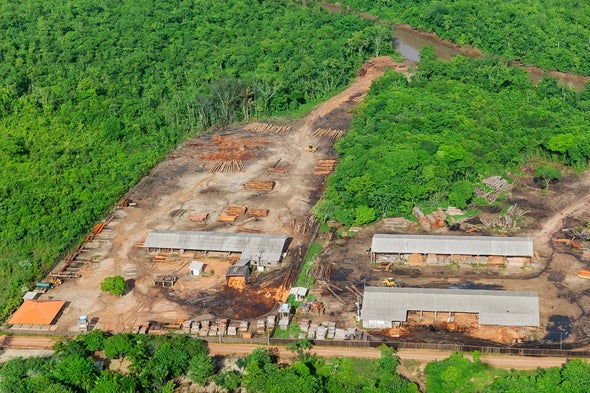(单词翻译:单击)
听力文本
This is Scientific American — 60-Second Science. I'm Christopher Intagliata.
Satellite imagery, like Google Earth, makes it easy for ecologists halfway around the world to check up on tropical forests — see illegal roads and logging, stuff like that. But the info is limited.
"Satellite data often tells you what happens after it's happened." Rhett Butler, the founder of Mongabay. com, that's an environmental science news website. In a perspective piece in the journal Science, he and his colleagues write that sound recordings could supplement satellite data, as another conservation tool.
"You can actually set up alerts. So you can hear things like chainsaws or gunshots in real time. So you can get out ahead of potential deforestation before it occurs."
Small audio recorders, some of which are solar-powered and hooked to cellphone grids for data upload, also give ecologists the ability to eavesdrop on a jungle's biodiversity over time: "If you're in a primary forest, you'll tend to see all the frequencies of the soundscape occupied by different species. (intact forest clip up and under) These are insects, birds, calling mammals, frogs, things like that."

As a comparison, here's a forest plot after selective logging — meaning some trees were cut, others left standing. "As you move into a more disturbed ecosystem, you'd start to see more gaps across the frequencies of that soundscape." Certain insects dominate. And the diversity of calls declines as disturbance increases.
And while the human ear is perceptive, algorithms are a much more powerful tool to comb through thousands of hours of data, to get a richer picture of changing tropical biodiversity. "And so that's where you get scalability, if you can create signatures for certain species or animal groups and then run an algorithm that matches those patterns against all the sound data."
Nowadays, many industries — like cattle farming, palm oil, soybean and paper production — are committing to zero deforestation goals, which can be hard to measure. But by coupling satellite data and camera traps with audio recordings, ecologists can keep their eyes — and ears — on what's going on in the jungle.
Thanks for listening for Scientific American — 60-Second Science. I'm Christopher Intagliata.
参考译文
这里是科学美国人——60秒科学。我是克里斯托弗·因塔利亚塔。
像谷歌地球这种卫星图像,让地球另一端的生态学家得以轻松地查看热带雨林的状况,比如看看是否存在偷渡路径和非法伐木。但这种信息是有限的。
“卫星数据通常在事后才会告知你发生了什么事。”环境科学新闻网站Mongabay. com的创始人瑞特·巴特勒说到。在《科学》期刊刊登的一篇观点文章中,他和同事写道,录音能作为另一种环境保护工具,来补充卫星数据。
“你可以设置警报。这样你就能实时地听到电锯声或枪声。你就可以在潜在的森林砍伐发生前采取行动。”
小型录音设备——其中有一些是太阳能的,还可以与手机网络相连用于上传数据——这也使生态学家有能力监听丛林多样性随时间的变化:“如果你身处原始森林中,你会更容易感受到音景的所有频率都被不同物种所占据。(完整的森林录音)这些声音包括昆虫、鸟类、哺乳动物、青蛙等生物。”
作为对比,以下是一片森林经过选择性采伐之后的声音,选择性采伐指一些树林被砍伐,其他树林继续保留。“当你进入一个遭破坏更严重的生态系统时,你会发现音景中各个频率之间的差别也会越大。”某些昆虫的叫声占主导地位。而随着遭破坏程度的上升,叫声的多样性会继续下降。
虽然人耳听觉灵敏,但算法是比人耳强大得多的工具,它可以梳理数千小时的数据,以更详细地了解热带生物多样性的变化。“因此,如果你能为某些物种或动物群体创建签名,然后运行一种算法,将这些声音模式与所有声音数据进行匹配,你就能对变化进行测量了。”
如今,包括畜牧业、棕榈业、大豆业和造纸业在内,许多产业都在致力于实现森林零砍伐的目标,而这可能很难衡量。但通过将卫星数据、隐藏的相机探头与录音相结合,生态学家的眼睛和耳朵就能随时监测丛林的情况。
谢谢大家收听科学美国人——60秒科学。我是克里斯托弗·因塔利亚塔。
译文为可可英语翻译,未经授权请勿转载!
重点讲解
重点讲解:
1. check up on 了解;查清;
It is certainly worth checking up on your benefit entitlements.
查清楚你可以享受哪些福利是绝对有必要的。
2. set up 创建;建立;安排;组建;
I set up the computer so that they could work from home.
我把电脑设置好,这样他们就可以在家办公了。
3. eavesdrop on 偷听;窃听;
The size of the data and the computing power needed mean hackers likely won't be able to eavesdrop on conversations at will, analysts say.
分析人士说,数据的规模和所需的计算能力意味着黑客们很可能无法随意窃听手机通话。
4. comb through 在(信息)中仔细搜寻;
They combed through the files for evidence of fraud.
他们查遍档案搜寻欺诈的证据。


